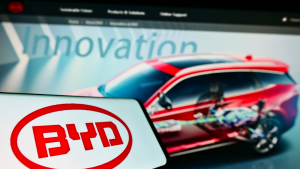
In this article, I will focus on established automakers rather than electric-vehicle startups. That’s because I’ve written a great deal about the latter firms in other recent columns. While EV startups are high-risk growth names, the automaker stocks I will present are lower-risk, growth-at-a-reasonable price (GARP) equities more suitable for older, conservative investors. Like all GARP stocks, however, these names can generate a great deal of profits and are extremely profitable, so there is very little risk of them going bankrupt. Moreover, these automakers should all benefit from lower interest rates going forward, along with the ever-increasing amount of software in vehicles, which should enable them to sell many subscriptions in the longer term. Also importantly, all three are well-positioned to benefit meaningfully from the EV revolution.
BMW (BMWYY)

Last quarter, BMW’s (OTCMKTS:BMWYY) deliveries rose a healthy 5.8% year-over-year (YoY) to 622,000, while its profits in the first nine months of the year, excluding a large one-time gain in 2022, jumped by 900 million euros YoY.
Also impressively, BMW disclosed in November that “Level 3 highly automated driving, which allows drivers to take their hands off the steering wheel and temporarily divert their attention away from the road, will soon be available in the new BMW 7 Series.” That achievement should enable the automaker to sell many more vehicles at meaningfully higher prices than many competitors that haven’t reached that milestone.
Also making BMW one of the best choices among automaker stocks is the fact that it sold over 13,000 EVs in the U.S. last quarter, showing it’s well-positioned for the EV revolution.
BMW’s shares are changing hands at an extremely low forward price-earnings ratio of just six.
General Motors (GM)

Even though a workers’ strike meaningfully lowered General Motors‘ (NYSE:GM) production last quarter, it still sold more vehicles than any other automaker in the U.S. in Q3. Specifically, its deliveries jumped 21% to 674,336 vehicles YoY.
“Robust sales of traditional, gas-powered pickup trucks and new SUVs continued to drive gains, along with fleet sales,” Investor’s Business Daily noted.
But GM also delivered over 20,000 EVs in Q3 in America, putting it among the leading sellers of EVs in the country. The automaker delivered 3,000 Cadillac Lyriq EVs, showing it’s becoming a contender in the luxury EV space. Further, the automaker launched its Chevrolet Blazer and Silverado EVs after mid-year, so it is entering the EV truck race in a big way in Q4.
Although GM’s Cruise autonomous unit is flailing, the company’s Super Cruise offering is reportedly among the best in the business.
And increasing my confidence in GM stock, the company unveiled a new $10 billion stock buyback program in November.
BYD (BYDDF)

Chinese electric vehicle and battery maker BYD (OTCMKTS:BYDDF) reported very impressive third-quarter results as its profit soared an incredible 82% versus the same period a year earlier to $1.4 billion.
And in Q3, BYD sold almost as many EVS as Tesla (NASDAQ:TSLA), unloading 430,000 to Tesla’s 430,000. During Q4, BYD is expected to sell a very impressive 500,000 such units, eclipsing Tesla’s 475,000 EVs.
In a note to investors last month, investment manager Bernstein wrote that BYD’s cost and scale advantages are superior to those of Tesla. The investment manager believes the market capitalization of BYD, which is currently about $76 billion, should move meaningfully closer to Tesla’s $810 billion.
Given BYD’s rapid growth and its exposure to the battery and chip businesses, BYD’s forward price-earnings ratio of 15 is quite low.
On the date of publication, Larry Ramer did not hold (either directly or indirectly) any positions in the securities mentioned in this article. The opinions expressed are those of the writer, subject to the InvestorPlace.com Publishing Guidelines.






